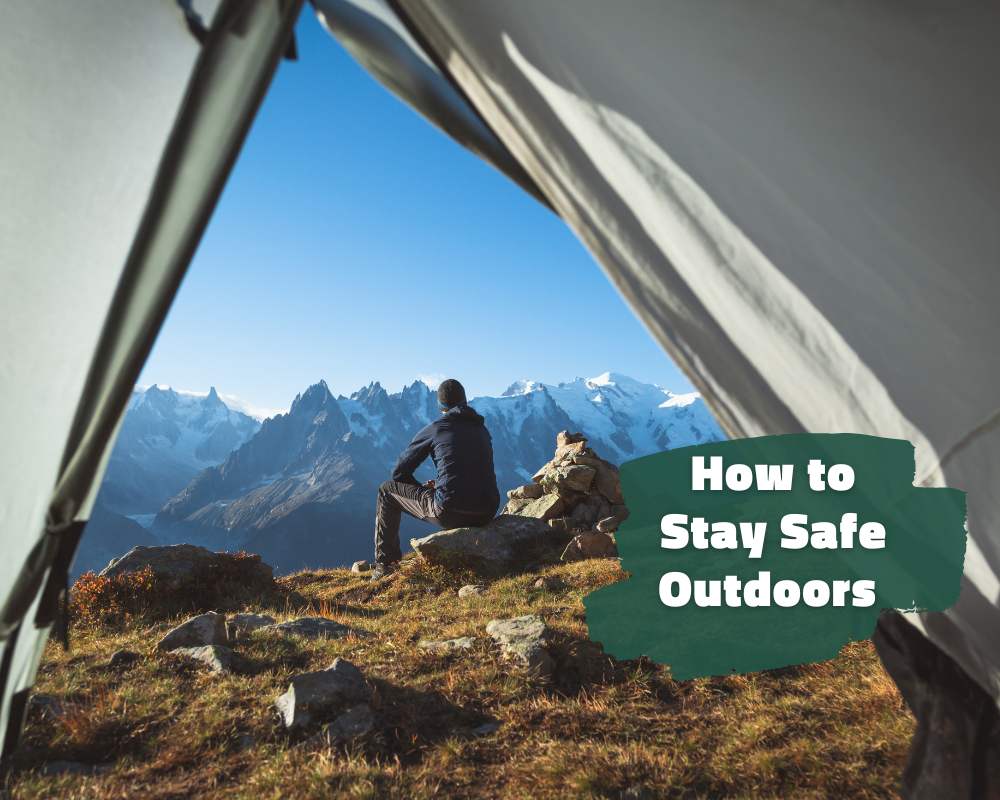Going on an outdoor adventure can be an exciting and fulfilling experience, but it can also be risky if you don’t take the necessary precautions. Whether you’re hiking, camping, or exploring new areas, it’s important to prioritize safety to ensure that you have a successful and enjoyable trip.
A great way to ensure safety is by following safety guidelines and being prepared for any situation that may arise. In this article, you’ll explore some tips and strategies for staying safe on your outdoor adventures, so that you can have a memorable and risk-free experience in the great outdoors.
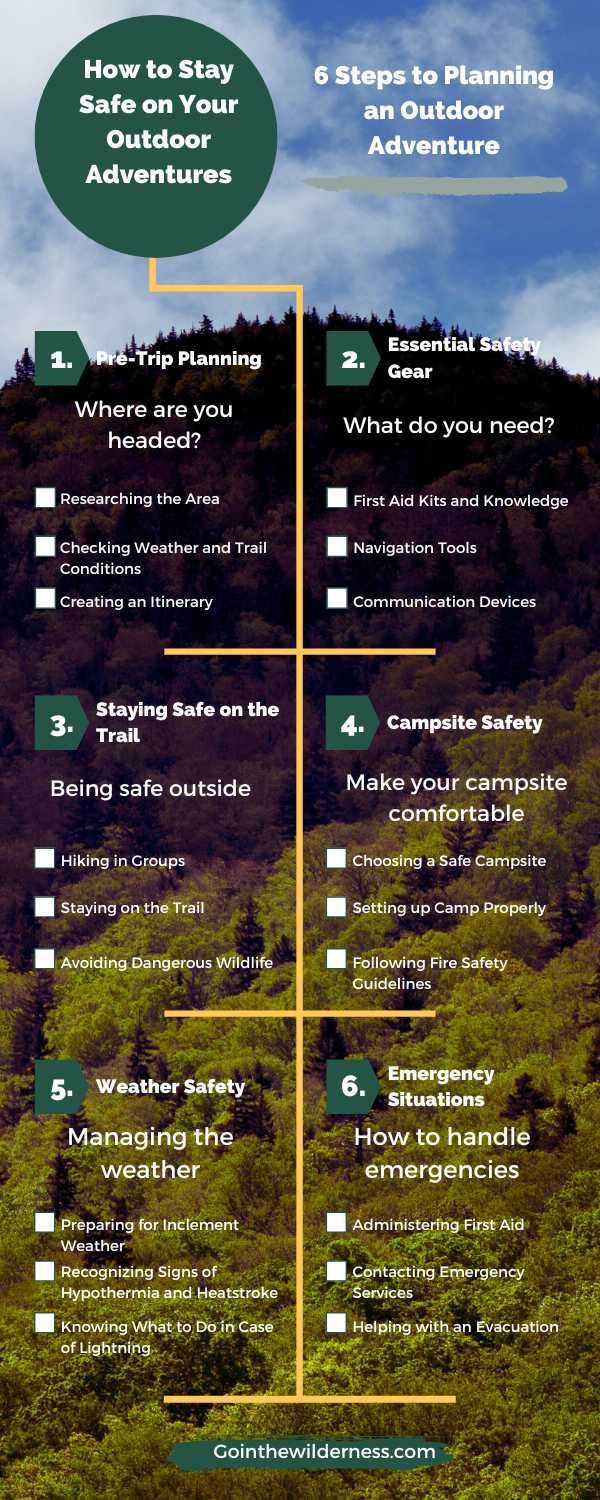
Pre-Trip Planning: Researching the Area, Checking Weather and Trail Conditions, and Creating an Itinerary
To ensure a safe outdoor adventure, you first need to do adequate research and planning before your trip. Let’s take a detailed look at this preparation.
Researching the Area
Whether you’ll be exploring a nearby park or a remote wilderness, you should first get familiar with the area before you set out on your adventure. Do some research and familiarize yourself with the area’s terrain, natural features, and potential hazards; if you know what to expect, you can plan your adventure, pack appropriate gear, and choose a safe and suitable route. During your research, you should also make sure to identify potential risks, such as wildlife or dangerous weather patterns, which you can then prepare for accordingly. The more you know, the better you’ll fare during your adventure, as you’ll be better prepared to make on-the-spot decisions—like avoiding certain areas or altering your itinerary.
Checking Weather and Trail Conditions
Checking weather and trail conditions before setting off is another vital step to ensure your safety. It allows you to prepare for potential weather-related risks, like extreme temperatures or heavy rainfall, which can otherwise lead to serious health problems like hypothermia or heat exhaustion. Moreover, knowing the trail conditions—such as obstacles, inclines or declines, or unstable ground—can help prevent accidents and injuries. For example, if you know your planned trail will be snowy or icy, you can plan to wear the right kit to avoid slipping over. Or, for instance, if you know you’ll encounter a river with rapids and high water levels, you’ll know to select the appropriate route, equipment, and clothing. So, by doing your research beforehand and preparing yourself accordingly, you can enjoy a fun and safe experience.
Creating an Itinerary
Additionally, creating an itinerary is essential for emergency preparedness during outdoor activities. By planning your route and sharing it with someone (e.g. a friend or loved one), you create a safety net in case of an emergency. If you get lost, injured, or stranded, your itinerary can help rescue teams locate you more quickly, which can potentially reduce your exposure to harsh weather and other hazards. What’s more, creating an itinerary forces you to consider factors such as the availability of water sources, shelter, and potential hazards, which can help you pack appropriate gear, bring enough food and water, and make informed decisions about when and where to rest or seek shelter. Having a well-planned itinerary should give you (and your loved ones!) peace of mind during your trip.
Essential Safety Gear: First Aid Kits, Navigation Tools, and Communication Devices
For every outdoor trip, you must also equip yourself with safety kits and devices. Don’t overlook this; you never know when you’ll encounter an emergency, and having the right gear can save lives.
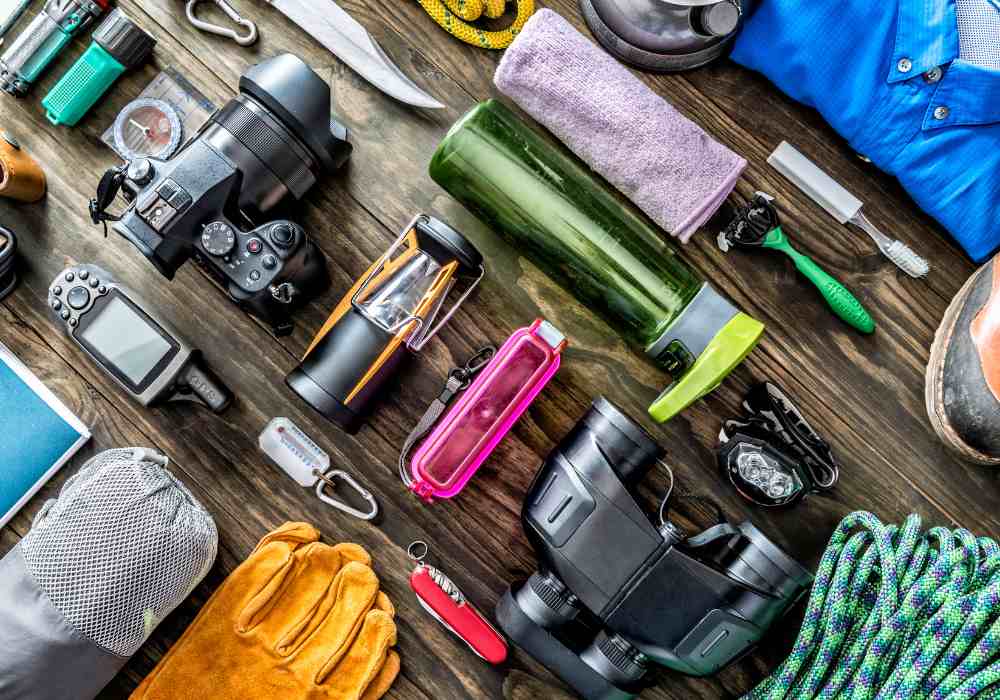
First Aid Kits and Knowledge
First, it is imperative that you bring a first aid kit on your trip; accidents can happen at any time! With a well-stocked first aid kit, you can prevent minor injuries from worsening and manage more serious ones until professional help arrives, especially in remote areas. As a guide, a comprehensive first aid kit should include bandages, antiseptics, pain relievers, and necessary medication. Furthermore, you should ideally have some basic first aid knowledge and know how to use the contents of your kit properly. (You can gain this knowledge in some online and in-person bushcraft courses). There’s no doubt about it: Being prepared with the right safety equipment and knowledge will maximize your chances of a safe outdoor adventure.
Navigation Tools
Navigation is also essential for outdoor safety. Firstly, it helps you plan your route better before you set off and, secondly, once you’ve set off, it helps you find your way better and avoid getting lost. Maps, compasses, and GPS devices are all vital navigational tools; they can help you stay on course and make informed decisions about your route, especially if you encounter obstacles, unfamiliar areas, or difficult weather. Whichever your chosen navigation method, make sure you also have a backup navigation method in case one of them fails. For instance, don’t just rely on a GPS device, but take a physical map with you on your trip as well, just in case.
Communication Devices
Furthermore, communication devices are a must-have during outdoor adventures—they can be a lifesaver if you get lost, stuck, or injured. Here are some examples of communication devices you can bring:
- Signaling devices like whistles or mirrors: You can use these to attract the attention of rescuers or other hikers, if you get injured or stuck.
- A working cell phone: This allows you to make calls for assistance.
- A two-way radio: You can use this to communicate with other members of your group or to contact emergency services.
- A personal locator beacon: This can send a distress signal to search and rescue teams, providing them with your location information.
Additionally, it’s important to ensure that you know how to use your communication devices properly and that they are well-charged and in good condition before your trip. You can always bring a portable charger along with you, too. To sum up, having the right communication tools and skills can significantly increase your chances of getting help if you get lost or injured.
Staying Safe on the Trail: Hiking in Groups, Staying on the Trail, and Avoiding Dangerous Wildlife
Know that, for safety, it’s not always just about the equipment you take—it’s how you go about your adventure, too. Hiking in groups, sticking to your trail, and avoiding dangerous wildlife are all highly recommended.
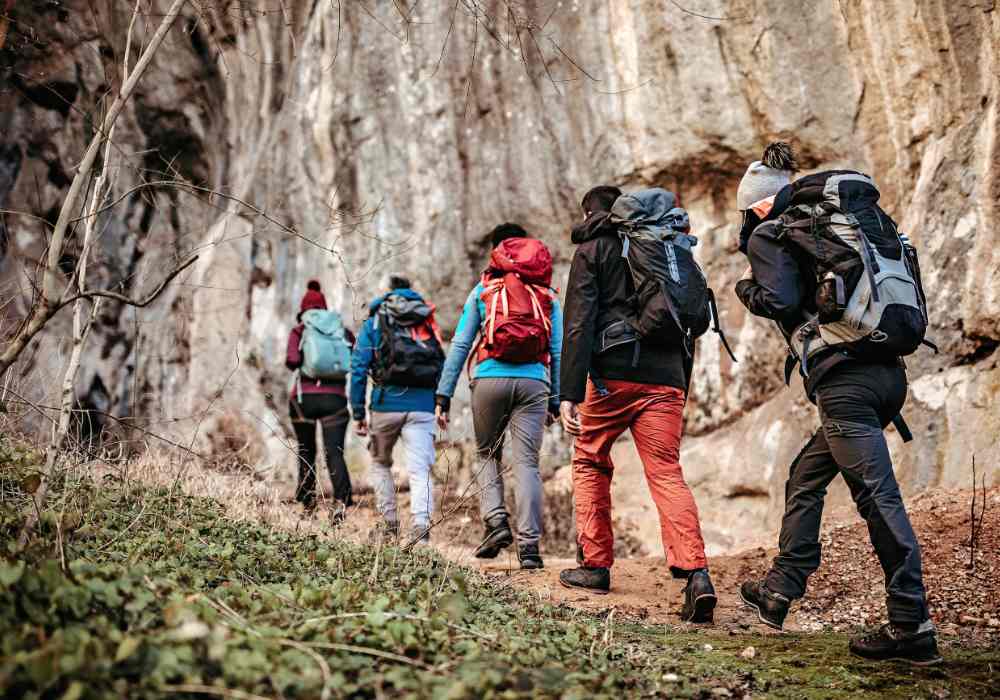
Hiking in Groups
Hiking in a group is a wise decision for outdoor safety—for multiple reasons. Firstly, it offers a higher level of safety and security, as there are more people available to provide assistance in case of an emergency or injury. What’s more, larger groups are more likely to deter unwanted wildlife and fend off animal attacks. Hiking with a group also means that the load of carrying essential supplies can be shared, resulting in lower chances of individual injury. Lastly, group hikes can be a more enjoyable and social experience, letting you share the beauty and challenges of the trail while learning new skills and tips from each other.
Staying on the Trail
Whether or not you’re hiking in a group, it’s also imperative that you stay on your designated trail. This helps prevent you from getting lost or disoriented, thereby reducing the risk of accidents or injuries. Sticking to the trail also minimizes your impact on the surrounding ecosystem, thus preserving fragile plant life and habitats. By contrast, straying off the trail can lead to irreversible ecological damage, as well as encounters with hazardous terrain. By respecting the trail and staying within its boundaries, you can help protect the environment and ensure it remains a safe and enjoyable destination for future generations.
Avoiding Dangerous Wildlife
Avoiding dangerous wildlife is another crucial aspect of outdoor safety, and it requires careful attention and preparation. To stay safe, you should do your research on the types of wildlife in the area and maintain a safe distance from risky species. Additionally, it’s recommended to avoid some areas altogether if dangerous animals are known to be present. You can also prevent curious animals from coming to find you by storing food and other scented items carefully in properly sealed containers. This is an important step to remember at your campsite in particular; you don’t want any unwelcome visitors in the night! All in all, by taking these steps, you can reduce the risk of animal attacks or other dangerous encounters.
Campsite Safety: Choosing a Safe Campsite, Setting up Camp Properly, and Following Fire Safety Guidelines
The previous section touched on campsite safety and how you can avoid attracting animals with scents and food. There’s far more to campsite safety than that, though—so let’s take a closer look!
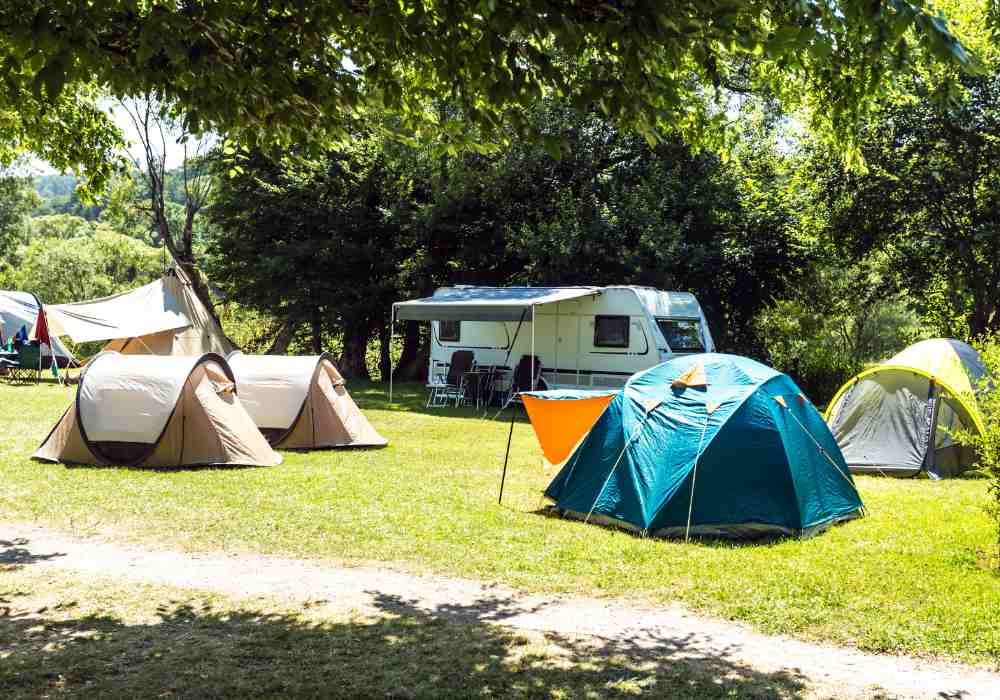
Choosing a Safe Campsite
Firstly, you need to choose a safe place to set up camp. This is absolutely essential. To select a good campsite, consider the potential hazards in the area, such as dead trees, rocky cliffs, or bodies of water, and avoid camping near them. Additionally, you should be aware of the presence of wildlife in the area and choose a campsite that’s away from areas with recent wildlife activity. It’s also important to select a site that’s well-drained (i.e. has a low flood risk), suitably sized, and close enough to water sources.
Setting up Camp Properly
A proper camp setup is another way to ensure safety and comfort in the great outdoors. By choosing an even, level location for your tent, you can prevent falls and ensure a good night’s sleep. To achieve this, avoid camping on slopes or in areas where water could accumulate during rainfall. Then, after selecting a suitable location, you should secure your tent using stakes and guy lines to prevent it from blowing over in high winds. Also, you can establish designated areas for cooking, eating, and gear storage, and keep them a safe distance away from your tent.
Following Fire Safety Guidelines
Finally, a safe outdoor adventure requires strict adherence to fire safety guidelines. This will protect the environment and ensure your safety, too. Thus, make sure to use designated fire areas and follow local restrictions to prevent wildfires. After you choose a location for your fire, never leave the fire unattended and ensure that, once done, you extinguish it fully before leaving. Check the ground for any smoke or embers and make sure they are fully put out.
Weather Safety: Preparing for Inclement Weather, Recognizing Signs of Hypothermia and Heatstroke, and Knowing What to Do in Case of Lightning
Wherever you’re going and whatever season of the year, the weather can always be unpredictable. You need to be prepared for this and know what to do.
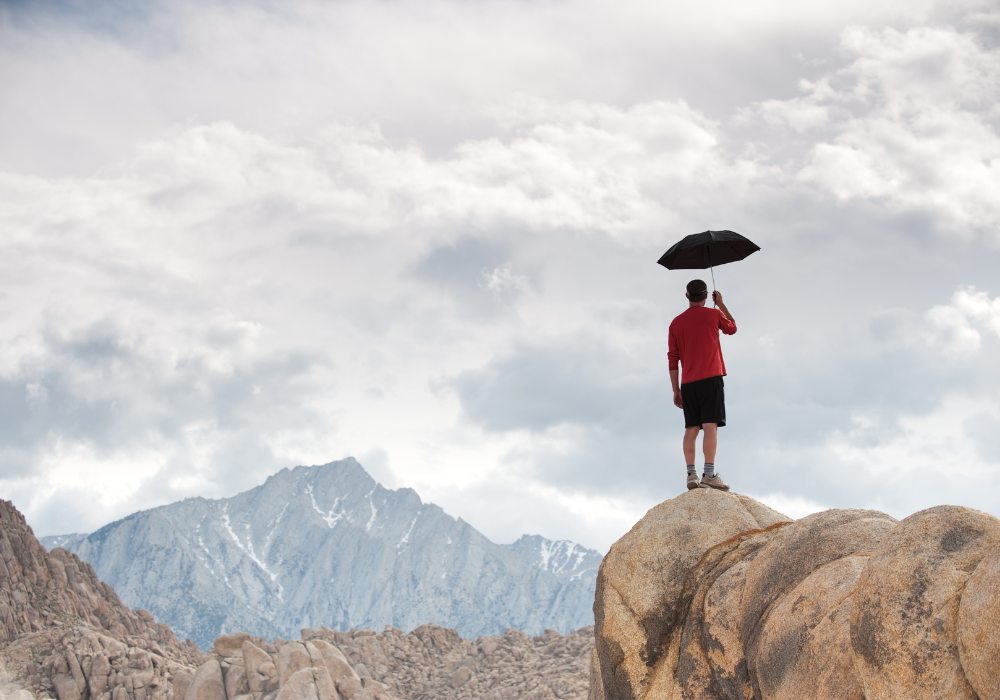
Preparing for Inclement Weather
Don’t assume you’ll have perfect weather during your trip; conditions can change rapidly and unexpectedly. Thus, always pack gear like waterproof jackets, moving blankets, boots, and layers, in case you encounter unexpected spells of rain or cold. Ideally, you should also stay informed about the weather during your trip and monitor conditions in case you need to make any last-minute changes to your route. It’s better to delay or modify your itinerary than to risk facing extreme weather conditions.
Recognizing Signs of Hypothermia and Heatstroke
Hypothermia is caused by exposure to cold or wet temperatures, and can lead to symptoms such as shivering, numbness, dizziness, confusion, slurred speech, and loss of coordination. In severe cases, it can cause unconsciousness and death. That’s why it’s important to know the early signs of hypothermia, so you can spot it and take action before it’s too late. The same goes for heatstroke; know that the warning signs of heatstroke include a rapid heartbeat, headaches, dizziness, nausea, and confusion. Being aware of these warning signs will help you recognize signs of illness sooner and know to take steps to prevent it from worsening. If your symptoms of hypothermia or heatstroke are severe, you should seek medical attention immediately.
Knowing What to Do in Case of Lightning
To stay safe during outdoor activities, it is also important to be prepared for sudden weather changes like lightning strikes. Lightning can strike from up to ten miles away and cause severe injuries or even death. To avoid this danger, you need to be aware of the weather forecast and plan accordingly. If you end up in a situation where lightning is going to strike, you should seek shelter immediately—preferably in a building or car, if possible. If that’s not possible, find a low-lying area and avoid tall trees and metal objects. Crouch down low with your feet together and hands on your knees. Wait out the storm for at least 30 minutes after the final thunderclap before you resume your activities.
Emergency Situations: What to Do in Case of Injury, Illness, or Other Emergencies
Finally, it’s good to have a strategy in place so you know what to do in case of an emergency. You should first assess the situation, then administer first aid or call the emergency services, and assist with an evacuation if needed.
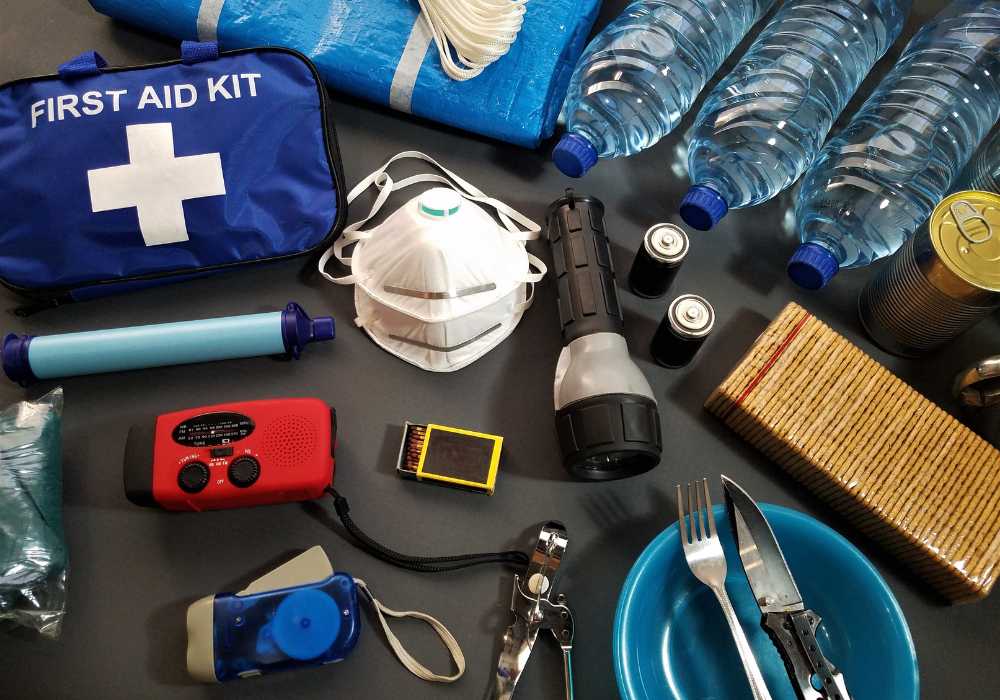
Administering First Aid
When you encounter an emergency, the first step is to evaluate the circumstances and gauge the extent of the emergency. This critical step will enable you to make an informed decision about the nature of the assistance required and the urgency with which it needs to be sought. In the event that someone has sustained injuries, you should provide first aid as needed, as long as you have the right equipment and training to do so. First aid may encompass a range of activities such as dressing wounds, immobilizing fractured bones, or administering CPR.
Contacting Emergency Services
In case of a severe situation, or if you do not have the right expertise or supplies, you must contact the emergency services without delay. Do this by promptly calling the appropriate authorities, such as the police, fire department, or ambulance service, and provide them with essential information like your location and a detailed account of the emergency. This will help ensure that the appropriate response team can reach you as quickly as possible. Also, once the emergency responders are en route, it is important to adhere to their advice and instructions. For instance, they may provide guidance on how to move the injured person to a safer area, or they might instruct you to stay in the same place until they arrive. It is crucial to follow these recommendations.
Helping with an Evacuation
In certain situations, you might need to evacuate an injured person to a medical facility as quickly and safely as possible. If the injured person is unable to move on their own, you may need to carry them out of the area, with or without assistance from others. When you’re doing this, take precautions to ensure the safety of both the injured person and those providing assistance. Use the right gear and equipment, and maintain awareness of your surroundings and the potential risks in the environment. That way, you can avoid causing further accidents and injuries during evacuation. Also, make sure to keep a check on your own physical and mental health, and seek medical attention if you feel you need it. However much you want to help, remember that your health is paramount, too.
Conclusion: The Importance of Following Safety Guidelines to Have a Safe and Enjoyable Outdoor Adventure
To conclude, there are various key elements to staying safe on outdoor adventures. You need to plan your trip carefully, take the right devices and gear with you, and always be prepared for the worst and the unexpected.
Overall, the more knowledge you have and the better prepared you are, the safer and more enjoyable your outdoor adventures will be. When it comes to your life and health, it’s certainly worth the effort.
I am Bruno. Navigating the urban rush by day, I find peace under the stars by night. Alongside my loyal companion and co-adventurer Lilith, we explore the balance between city life and nature’s embrace. Through writing and films, I delve into bushcraft and the wild’s allure.
GointheWilderness is my bridge between these two realms, guiding you to reconnect with your innate wilderness.
Eden is here and now; join us in rediscovering it.

